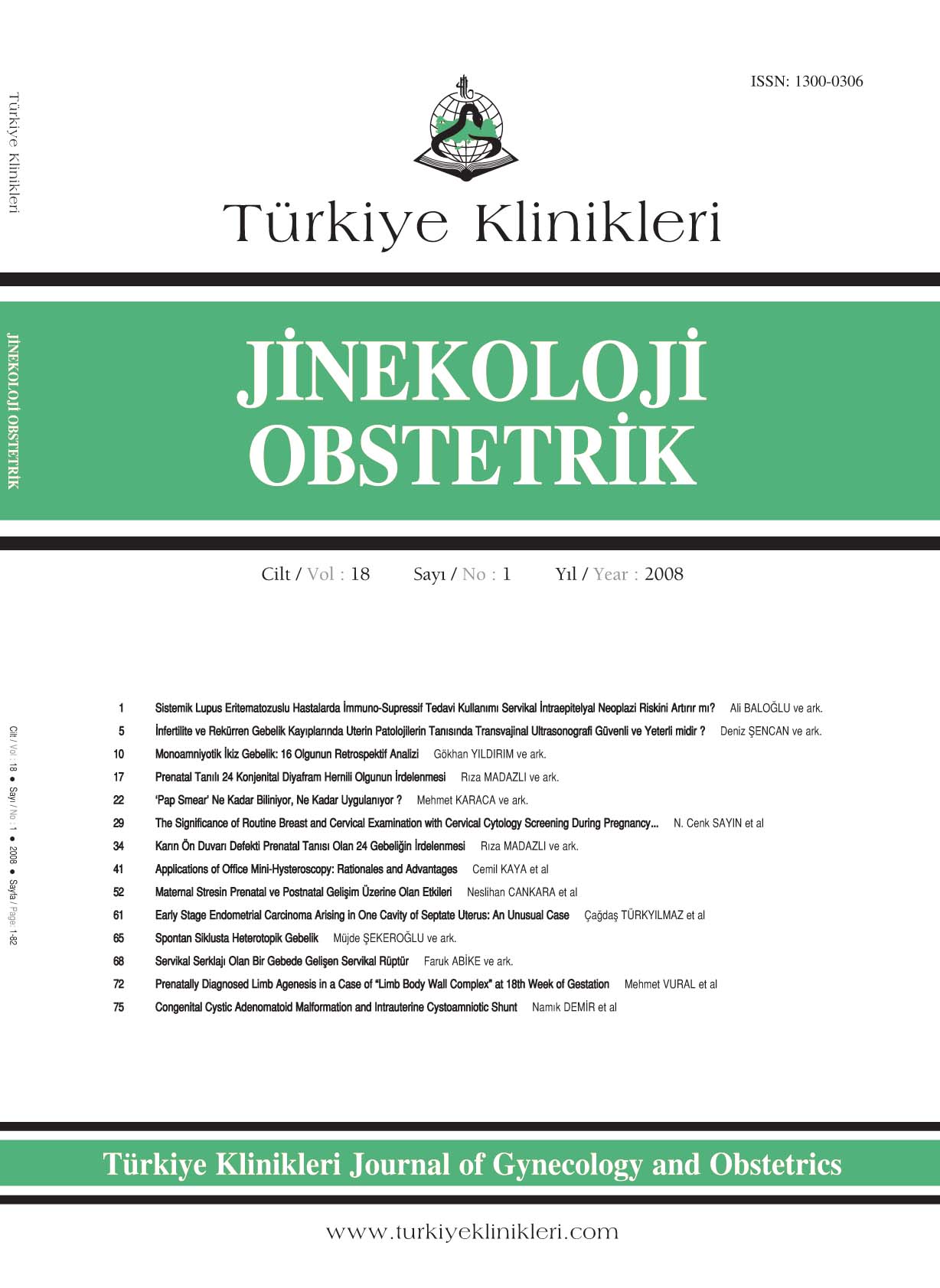Open Access
Peer Reviewed
ORIGINAL RESEARCH
3496 Viewed1261 Downloaded
Evaluation of 24 Cases of Prenatally Diagnosed Abdominal Wall Defects
Karın Ön Duvarı Defekti Prenatal Tanısı Olan 24 Gebeliğin İrdelenmesi
Turkiye Klinikleri J Gynecol Obst. 2008;18(1):34-40
Article Language: TR
Copyright Ⓒ 2025 by Türkiye Klinikleri. This is an open access article under the CC BY-NC-ND license (http://creativecommons.org/licenses/by-nc-nd/4.0/)
ÖZET
Amaç: Prenatal dönemde karın ön duvarı defekti tanısı alan olguların klinik özelliklerinin ve perinatal sonuçlarının değerlendirilmesi Gereç ve Yöntemler: Ana Bilim Dalımızda Ocak 1998-Aralık 2006 tarihleri arasında gastroşizis ve omfalosel tanısı alan 24 olgu retrospektif olarak irdelendi. Gebelerin tanı haftası, ilave yapısal ve kromozomal anomali varlığı, doğum hafta ve şekli ile perinatal sonuçları değerlendirildi. Bulgular: Batın ön duvarı defekti olan 24 fetusun 11'inde gastroşizis, 13'ünde omfalosel mevcuttu. Gastroşizis ve omfalosel tanısı alan gebelerin nulliparite oranları ve yaşlarının ortalaması sırasıyla %72.7, 22.5 ± 5.1 ve %53.8, 26.8 ± 2.0 olarak bulundu. Gastroşizis olgularında ilave yapısal ve kromozomal anomali saptanmadı. Omfalosel olgularının ise 4'ünde (%30.8) ilave yapısal anomali ve 1'inde (%7.7) kromozom anomalisi belirlendi. Gastroşizis ve omfalosel için perinatal mortalite oranlarımız sırasıyla %20 ve %44 olarak saptandı. Canlı doğan izole gastroşizis ve omfalosel olgularımızda sağkalım oranlarımız ise sırasıyla %88.8 ve %71.4 olarak belirlendi. Sonuç: Karın ön duvarı defektli fetusların antenatal dönemde tanısının konması, ilave yapısal ve kromozomal anomalilerin belirlenmesi, ekip anlayışı içinde takip edilmeleri ve uygun merkezlerde doğumların gerçekleşmesine olanak sağlaması açısından son derece önemlidir.
Amaç: Prenatal dönemde karın ön duvarı defekti tanısı alan olguların klinik özelliklerinin ve perinatal sonuçlarının değerlendirilmesi Gereç ve Yöntemler: Ana Bilim Dalımızda Ocak 1998-Aralık 2006 tarihleri arasında gastroşizis ve omfalosel tanısı alan 24 olgu retrospektif olarak irdelendi. Gebelerin tanı haftası, ilave yapısal ve kromozomal anomali varlığı, doğum hafta ve şekli ile perinatal sonuçları değerlendirildi. Bulgular: Batın ön duvarı defekti olan 24 fetusun 11'inde gastroşizis, 13'ünde omfalosel mevcuttu. Gastroşizis ve omfalosel tanısı alan gebelerin nulliparite oranları ve yaşlarının ortalaması sırasıyla %72.7, 22.5 ± 5.1 ve %53.8, 26.8 ± 2.0 olarak bulundu. Gastroşizis olgularında ilave yapısal ve kromozomal anomali saptanmadı. Omfalosel olgularının ise 4'ünde (%30.8) ilave yapısal anomali ve 1'inde (%7.7) kromozom anomalisi belirlendi. Gastroşizis ve omfalosel için perinatal mortalite oranlarımız sırasıyla %20 ve %44 olarak saptandı. Canlı doğan izole gastroşizis ve omfalosel olgularımızda sağkalım oranlarımız ise sırasıyla %88.8 ve %71.4 olarak belirlendi. Sonuç: Karın ön duvarı defektli fetusların antenatal dönemde tanısının konması, ilave yapısal ve kromozomal anomalilerin belirlenmesi, ekip anlayışı içinde takip edilmeleri ve uygun merkezlerde doğumların gerçekleşmesine olanak sağlaması açısından son derece önemlidir.
ANAHTAR KELİMELER: Karın ön duvarı, gastroşizis, omfalosel, prenatal tanı
ABSTRACT
Objective: To evaluacte the clinical characteristics and perinatal outcomes of prenatally diagnosed abdominal wall defect cases. Material and Methods: We present a retrospective study of the 24 consecutive cases of omphalocele and gastroschisis diagnosed in utero during the period from 1998 to 2006. Gestational age at diagnosis and delivery, additional malformations and chromosomal anomalies and perinatal outcomes were evaluated. Results: There were 11 cases of gastroschisis and 13 cases of omphalocele. The rates of nulliparity and mean maternal ages for gastroschisis and omphalocele were 72.7 %, 22.5 ± 5.1 and 53.8 %, 26.8 ± 2.0 respectively. No additional malformation and chromosomal anomalies were detected in fetuses with gastroschisis. Additional malformations and chromosomal anomalies in fetuses with omphalocele were seen in 4 (30.8 %) and 1 (7.7 %) of the cases respectively. Perinatal mortality rates for gastroschisis and omphalocele were 20 % and 44.4 % respectively. Survival rates for isolated live born fetuses with gastroschisis and omphalocele were 88.8 % and 71.4 % respectively. Conclusion: Prenatal diagnosis of fetuses with abdominal wall defects allows for a careful search for additional chromosomal and structural anomalies, accurate counselling and follow-up of the pregnancies and delivery at a perinatal center where neonatal and surgical expertise are immediately available.
Objective: To evaluacte the clinical characteristics and perinatal outcomes of prenatally diagnosed abdominal wall defect cases. Material and Methods: We present a retrospective study of the 24 consecutive cases of omphalocele and gastroschisis diagnosed in utero during the period from 1998 to 2006. Gestational age at diagnosis and delivery, additional malformations and chromosomal anomalies and perinatal outcomes were evaluated. Results: There were 11 cases of gastroschisis and 13 cases of omphalocele. The rates of nulliparity and mean maternal ages for gastroschisis and omphalocele were 72.7 %, 22.5 ± 5.1 and 53.8 %, 26.8 ± 2.0 respectively. No additional malformation and chromosomal anomalies were detected in fetuses with gastroschisis. Additional malformations and chromosomal anomalies in fetuses with omphalocele were seen in 4 (30.8 %) and 1 (7.7 %) of the cases respectively. Perinatal mortality rates for gastroschisis and omphalocele were 20 % and 44.4 % respectively. Survival rates for isolated live born fetuses with gastroschisis and omphalocele were 88.8 % and 71.4 % respectively. Conclusion: Prenatal diagnosis of fetuses with abdominal wall defects allows for a careful search for additional chromosomal and structural anomalies, accurate counselling and follow-up of the pregnancies and delivery at a perinatal center where neonatal and surgical expertise are immediately available.
MENU
POPULAR ARTICLES
MOST DOWNLOADED ARTICLES





This journal is licensed under a Creative Commons Attribution-NonCommercial-NoDerivatives 4.0 International License.










